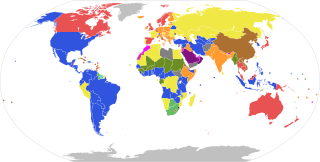
Constitutional monarchy, also known as limited monarchy, parliamentary monarchy or democratic monarchy, is a form of monarchy in which the monarch exercises their authority in accordance with a constitution and is not alone in making decisions. Constitutional monarchies differ from absolute monarchies in that they are bound to exercise powers and authorities within limits prescribed by an established legal framework.
A monarch is a head of state for life or until abdication, and therefore the head of state of a monarchy. A monarch may exercise the highest authority and power in the state, or others may wield that power on behalf of the monarch. Usually, a monarch either personally inherits the lawful right to exercise the state's sovereign rights or is selected by an established process from a family or cohort eligible to provide the nation's monarch. Alternatively, an individual may proclaim oneself monarch, which may be backed and legitimated through acclamation, right of conquest or a combination of means.
A monarchy is a form of government in which a person, the monarch, reigns as head of state for life or until abdication. The extent of the authority of the monarch may vary from restricted and largely symbolic, to fully autocratic, and may have representational, executive, legislative, and judicial functions.

Year 1241 (MCCXLI) was a common year starting on Tuesday of the Julian calendar.

Absolute monarchy is a form of monarchy in which the sovereign is the sole source of political power, unconstrained by constitutions, legislatures or other checks on their authority.

The House of Windsor is the reigning house of the United Kingdom and the other Commonwealth realms. The house's name was inspired by the historic Windsor Castle estate. Since it was founded on 17 July 1917, there have been five British monarchs of the House of Windsor: George V, Edward VIII, George VI, Elizabeth II, and Charles III. The children and male-line descendants of Queen Elizabeth II and Prince Philip, Duke of Edinburgh, also genealogically belong to the House of Oldenburg since Philip was by birth a member of the Glücksburg branch of that house.
The abolition of monarchy is a legislative or revolutionary movement to abolish monarchical elements in government, usually hereditary. The abolition of an absolute monarchy in favour of limited government under a constitutional monarchy is a less radical form of anti-monarchism that has succeeded in some nations that still retain monarchs, such as Sweden, Spain, and Thailand.

A coronation is the act of placement or bestowal of a crown upon a monarch's head. The term also generally refers to the ceremony which marks the formal investiture of a monarch with regal power. In addition to the crowning, this ceremony may include the presentation of other items of regalia, and other rituals such as the taking of special vows by the new monarch, the investing and presentation of regalia to them, and acts of homage by the new monarch's subjects. In certain Christian denominations, such as Lutheranism and Anglicanism, coronation is a religious rite. As such, Western-style coronations have often included anointing the monarch with holy oil, or chrism as it is often called; the anointing ritual's religious significance follows examples found in the Bible. The monarch's consort may also be crowned, either simultaneously with the monarch or as a separate event.
An elective monarchy is a monarchy ruled by a monarch who is elected, in contrast to a hereditary monarchy in which the office is automatically passed down as a family inheritance. The manner of election, the nature of candidate qualifications, and the electors vary from case to case. Historically, it was common for elective monarchies to transform into hereditary ones by repeated election of the previous rulers' children, or for hereditary monarchies to acquire elective or semi-elective succession laws, particularly following dynastic crises.
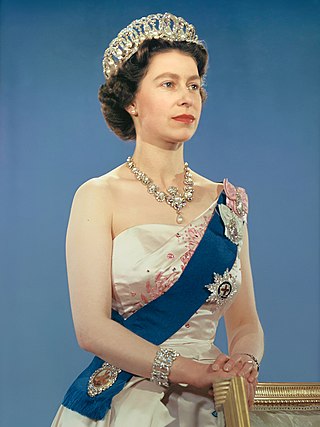
A queen regnant is a female monarch, equivalent in rank, title and position to a king. She reigns suo jure over a realm known as a kingdom; as opposed to a queen consort, who is married to a reigning king; or a queen regent, who is the guardian of a child monarch and rules pro tempore in the child's stead or instead of her husband who is absent from the realm, be it de jure in sharing power or de facto in ruling alone. A queen regnant is sometimes called a woman king. A princess, duchess, or grand duchess regnant is a female monarch who reigns suo jure over a principality or (grand) duchy; an empress regnant is a female monarch who reigns suo jure over an empire.
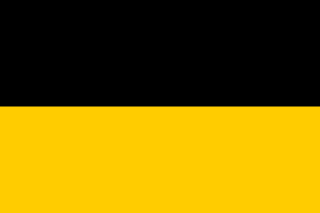
The Habsburg monarchy, also known as Habsburg Empire, or Habsburg Realm, was the collection of empires, kingdoms, duchies, counties and other polities that were ruled by the House of Habsburg. From the 18th century it is also referred to as the Austrian monarchy or the Danubian monarchy.
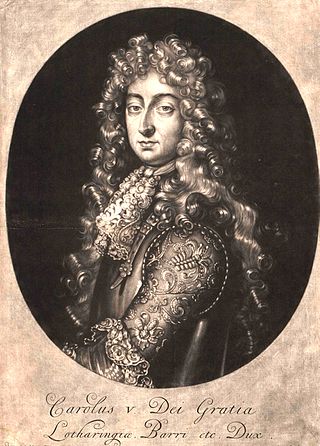
Charles V, Duke of Lorraine and Bar succeeded his uncle Charles IV, Duke of Lorraine as titular Duke of Lorraine and Bar in 1675; both duchies were occupied by France from 1634 to 1661 and 1670 to 1697.
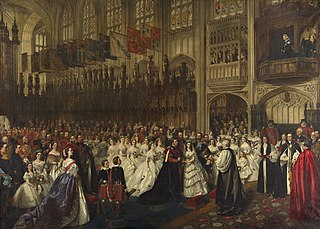
The royal descendants of Queen Victoriaand of King Christian IX, monarchs of the United Kingdom and Denmark, respectively, have become members of multiple European royal families. This was partially achieved by the marriage of Victoria's progeny with Christian's. By the time of her Diamond Jubilee in 1897, Victoria was known as the "grandmother of Europe". Also, Christian IX was nicknamed the "father-in-law of Europe".

Monarchism is the advocacy of the system of monarchy or monarchical rule. A monarchist is an individual who supports this form of government independently of any specific monarch, whereas one who supports a particular monarch is a royalist. Conversely, the opposition to monarchical rule is referred to as republicanism.

China was a monarchy from prehistoric times up to 1912, when a republic was established. The succession of legendary monarchs of China were non-hereditary. Dynastic rule began c. 2070 BC when Yu the Great established the Xia dynasty, and monarchy lasted until 1912 when dynastic rule collapsed together with the monarchical government. Various attempts at preserving and restoring the Chinese monarchy occurred during and following the Xinhai Revolution, but these regimes were short-lived and lacked widespread recognition.















































